EIGHT MOTHER PALMS AND INDIVIDUAL PALMS
Frederick Chu -- Shaolin Wahnam USA
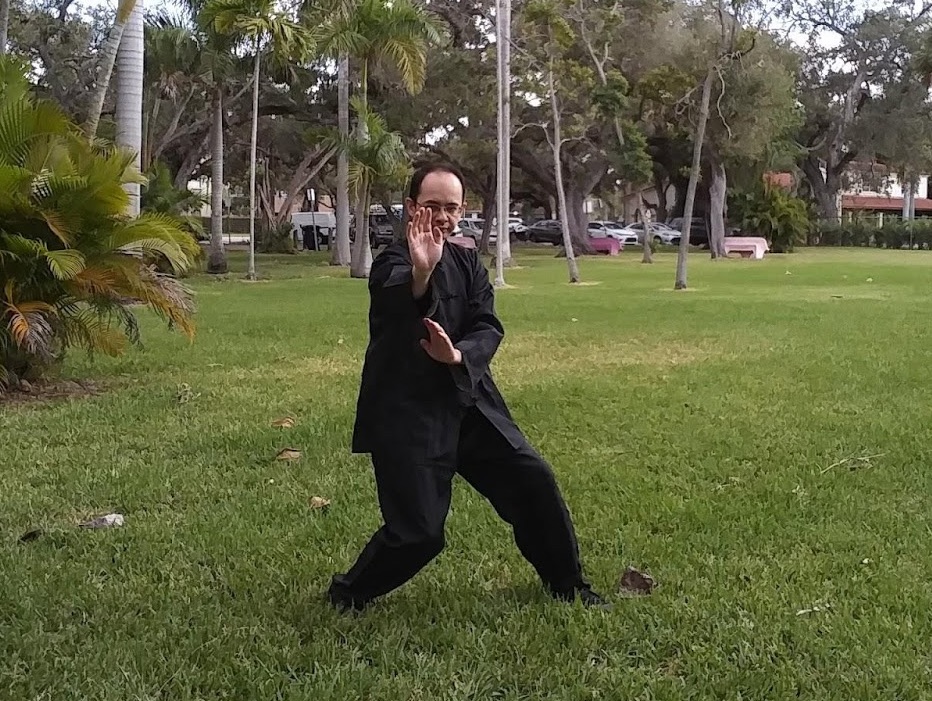
Green Dragon Tests Claw
28. Eight Mother Palms
While many sources state that Dong Hai Chuan taught the same first two or three Mother Palms to all of his students (Single Change Palm, Double Change Palm, and Smooth Flow Palm) [1, 3, 9, 17, 22], every school has its own versions of those Mother Palms. Some schools do not even have a series of exercises termed Mother Palms, but rather borrow Daoist terminology to term their force training exercises as Pre-Heaven Palms and their combat application techniques as Post-Heaven Palms.
Regardless, what follows is a brief overview of the Eight Mother Palms as taught in Shaolin Wahnam, drawing on both Grandmaster Wong's own direct teaching as well as my experiences through practice. Readers interested in the finer points of practice, including the force training of the Baguazhang opening pattern as applications not listed here, are encouraged to consult Grandmaster Wong's website reviewing his courses and sources on Baguazhang to find the answers they seek [15, 16].
29. Single Change Palm
In all schools of Baguazhang, the Single Change Palm is considered the most important of the Eight Mother Palms and is taught very shortly after the student is first introduced to Circle Walking. Shaolin Wahnam is no exception to the rule, with the two major patterns of its first Mother Palm being Bail Moon From Sea Bottom and Control a Galloping Horse.
Bail Moon From Sea Bottom is typically performed as a low reverse rising palm chop delivered from the Horse Riding stance. Like many techniques in Baguazhang, it is a "hidden" technique in that the angle of the attack as well as its intended target (the opponent's groin or lower abdomen) are easily hidden from the opponent's sight. The wide arc of the sweeping palm as it crosses in front of the body before sweeping downward and outward to slice upwards at an opponent's groin as performed in the Single Change Palm also provides another lesson to the perceptive student: the importance of transitional movements.
While some beginners might only see the final slicing palm at the end of the movement, the arm's sweep covers the entire body and thus can be used to train, for example, the body mechanics needed to brush away an incoming strike by circling it downwards and away (as seen in Taijiquan's Cloud Hands or Brush Knee Twist Step, also called Green Dragon Shoots Pearl, and Southern Shaolin's Plum Flower Set's Kitten Washes Face). The initial transitional movement can also be halted early on to terminate the circling arm sweep into a descending palm chop to the side of an opponent's face or onto their clavicle, a pattern known as Alone Chop the Hua Mountain (prosaically known as "the karate chop" by many laypersons).
Controlling a Galloping Horse follows immediately after Bail Moon From Sea Bottom and is performed in the opposite direction as Bail Moon From Sea Bottom. This reinforces another lesson that comes right at the start of Baguazhang training, namely being aware of opponents coming from all directions. Controlling a Galloping Horse essentially acts as an outward arm sweep that is used to grapple with an opponent, locking their arms, head, torso, or even legs into an awkward position.
While the Baguazhang classics typically advocate against wrestling with opponents [1, 4, 8, 22], the ability to capture an opponent and use them as a human shield is an important consideration when sparring multiple opponents. Perceptive martial artists familiar with kung fu might also notice that when Controlling a Galloping Horse is performed many times, it very closely resembles the Silk Reeling of Chen Taijiquan.
When the Eight Mother Palms are trained as stance practice combined with Circle Walking as mentioned above, practitioners in the Shaolin Wahnam Institute will typically choose Green Dragon Tests Claw as a characteristic stance to represent the Single Change Palm. Not only is it the primary stance from which a Baguazhang combatant engages their opponents, it develops the most generalized internal force out of all Baguazhang stances and hence its benefits most easily transfer to other purposes, such as focusing the force developed from this posture to other body parts or for other skills [17]. In this manner, it is similar to the Horse Riding stance of Shaolin kung fu or the Three Circle stance of Taijiquan: excellent for building force for all occasions.
30. Double Change Palm
The second Mother Palm consists of Yellow Dragon Shoots Tongue, Point to Heaven and Jab Earth, Swallow Skims on Water, and Horizontally Bar Rushing Horse. When completing a revolution of Circle Walking, the practitioner thrusts their reverse palm in one direct and immediately in the opposite direction, channeling force from the stance to the fingertips and typically aiming at fragile locations on an opponent's body such as the eyes, nose, or throat. Such targets, when struck, or even gestured towards, can raise apprehension in an opponent, and in fact, the 36 Songs and 48 Methods both speak favorably of repeatedly thrusting at an opponent's face if all else fails [1, 7, 9, 22].
Point to Heaven and Jab Earth is typically performed in a narrow T step or Two Character stance and is typically used as a withdrawing step from a longer stance to avoid an incoming powerful strike or kick. Thrusting the palms upwards and downwards provides an opportunity to dislodge grabs of all sorts, including grips to the throat, which are a common enough attack by all manner of combatant, trained and otherwise.
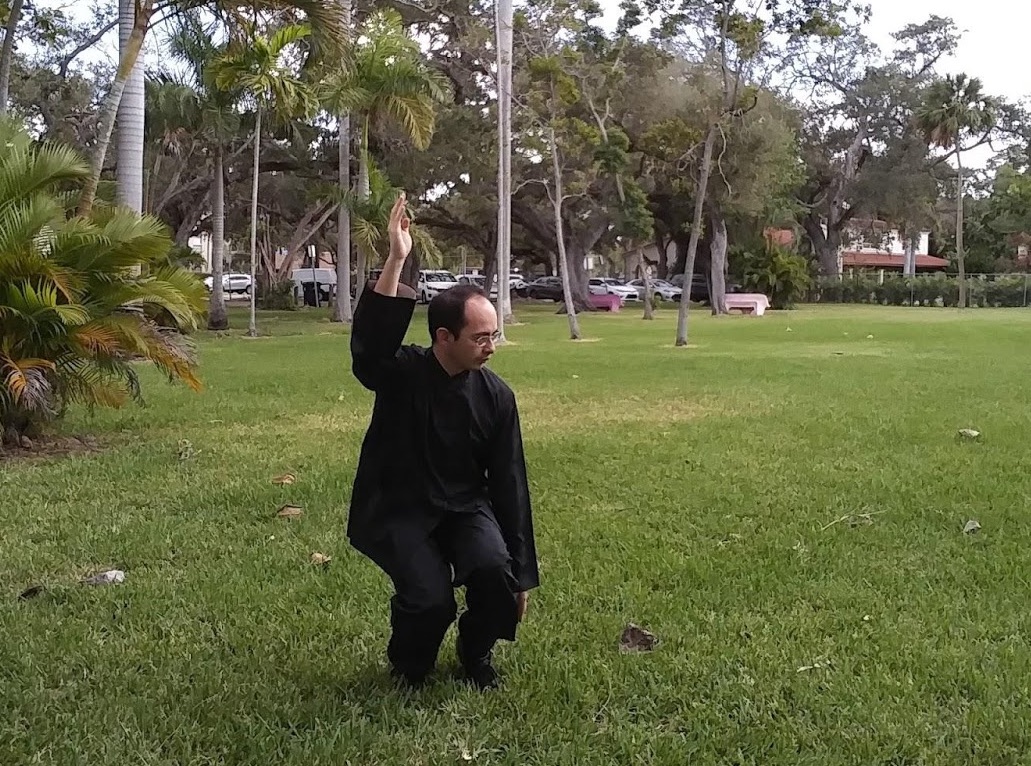
Point to Heaven and Jab Earth
Likewise, the simultaneously raised and sunken position of the arms provides coverage against that most feared attack used in Muai Thai, a clinch to the neck as well as repeated knee strikes. The raised palm thrusts upwards to dislodge the clinch (and can also be used to thrust at the opponent's throat or face) while the outside of the forearm is used to deflect away the opponent's thigh.
Do not make the mistake of attempting to meet the point of the attacker's knee with your forearm, which can result in your forearm or wrist being injured, but rather deflect away the inside of their thigh. You can then follow up with an appropriate technique such as pushing them away, planting your leg behind their standing leg and throwing them to the ground, or whatever else is necessary to keep yourself save. This is similar to a pattern called Plant Willow Before Camp in Southern Shaolin kung fu.
When used as a static posture for stance training, Point to Heaven and Jab Earth is exceedingly demanding on the legs, more so than the Horse Riding stance. Take care to allow your body weight to sink all the way to the ground without being caught up in overly tensed or locked knees, and you will reap excellent strength and flexibility in the hips. The position of the hands also quite naturally focuses force at each fingertip, not just for striking, but also for a deeply penetrating grip.
Swallow Skims on Water appears to be a confusing technique. After all, what possible use might there be for squatting down on one leg before springing up into the Bow Arrow stance while brushing the front arm forwards and upwards, especially after spinning around? An important principle to keep in mind, which is explored further as the student pursues the third and seventh Mother Palms, is how to effectively use spinning and circling while maintaining safe coverage from their opponent's attacks.
One possible application of Swallow Skims on Water is to get to an opponent's back or side and to deliver a single or double leg takedown (if one wishes to be merciful) or to thrust upwards at an opponent's groin with the full lifting force of the practitioner's legs and body. Most people lack sufficient conditioning at their genitals to sustain such a blow without at least being momentarily distracted by pain. Be wary of an opponent who is able to use a back-body kick against you and be ready to sink or step back in your stance. Such a kick is a common counter used in certain styles of both Northern and Southern Shaolin kung fu.
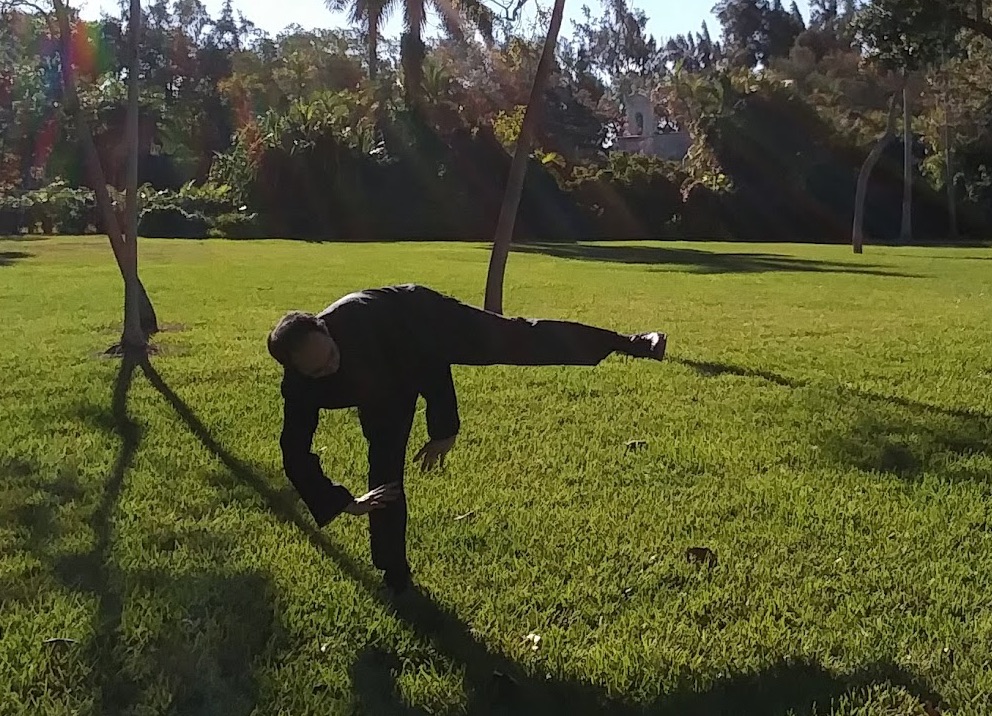
Side Body Kick
31. Examples of Side-Body and Back-Body kicks
Horizontally Bar Rushing Horse has a variety of uses. At its simplest usage, it can be used as a horizontal palm strike delivered from the Horse Riding stance, emitting almost every conceivable type of force, such as release force to send an opponent stumbling backwards, striking force to penetrate deeply into an opponent's abdomen, or sinking force to make an opponent crumple inwards on themselves by disrupting their structure at the waist and hips.
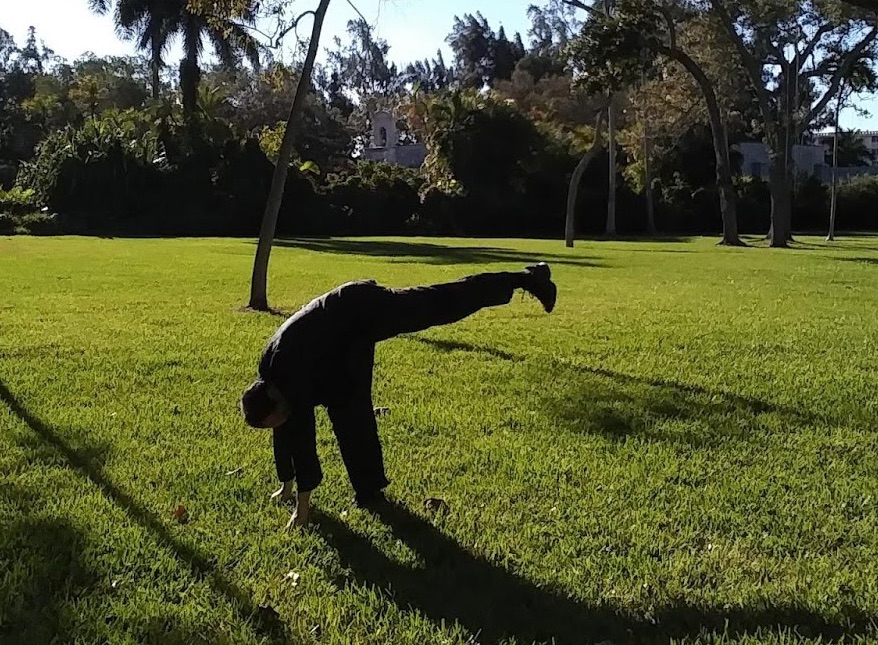
Back Body Kick
This pattern can also be used to keep an opponent at bay if they attempt to close in for a wrestler's shoot or to get to one's side or back, provided that you recognize what is going on quickly enough. In kung fu, it is very important to know the possible counters of any technique you plan to use, and hence a Baguazhang practitioner must know how to defeat their own trademark skill of getting to an opponent's back so that they can "counter the counter" and succeed regardless of an opponent's knowledge of counters. This requires a deeper level of force, skills, and tactics and is the mark of an expert.
32. Smooth Flow Palm
Smooth Flow Palm emphasizes much in the way of the threading palm, and is composed of Golden Dragon Spirals Pillar and two variations of Swimming Dragon Plays With Water performed in the Unicorn and Horse Riding stances.
Golden Dragon Spirals Pillar, which is essentially taking tight inward circling steps, sees further training in the seventh Mother Palm and forms the heart of Baguazhang movement, refining the skills developed from Circle Walking and tightening circles into spirals that allow a practitioner to flank an opponent as well as get to their backs with ease, especially if an opponent is delivering an overly committed attack.
Swimming Dragon Plays With Water is one of the most characteristic techniques of Dragon kung fu from both Northern and Southern Shaolin traditions, where swerving motions serve to a minimize an opponent's force with minimum effort, often without having to move the feet very much from their original position, and to allow a counter-attack to exposed vital points on the opponent's body. While the striking hand form may differ (such as the thread hand, sword finger, palm, or fist), the underlying principle of avoiding an opponent's ability to harm you with exactly as much movement as is needed to keep yourself safe while simultaneously being close enough to strike demands a high level of skill and hence is important to begin practicing early on in the Baguazhang fighter's training.
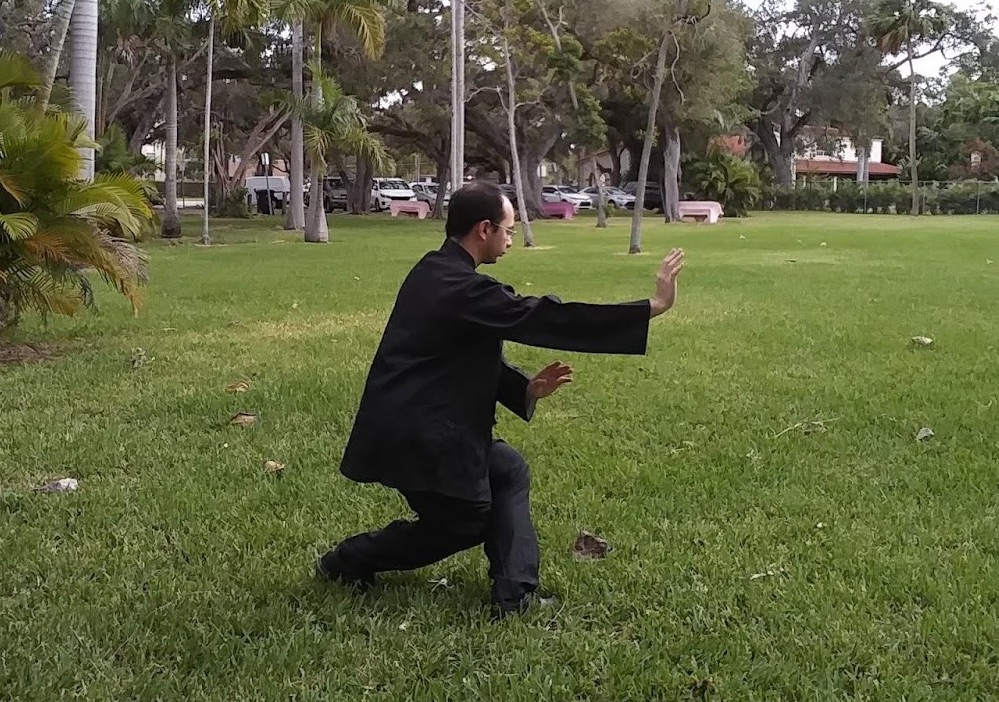
Swimming Dragon Play with Water
The variation of Swimming Dragon performed in the Unicorn stance provides many possible applications besides a continuation of the threading and swerving variation performed at the Horse Riding stance. Those skilled in leg techniques, including the famous Shaolin 36 Leg Techniques and the Shaolin 72 Qin-Na Techniques which are said to be incorporated into Baguazhang [16], besides anyone who has spent a suitable amount of time on their stances and footwork, will notice that bringing the thighs and knees close together on a retreat can be used to cover the groin and, if someone is fast, catch an opponent's hand or leg on its way to strike that part of the body.
Practitioners with experience in grappling and an intermediate level of sensing skills will be able to take that one step further with an opponent attempting a single or double leg takedown as seen in grappling and wrestling; sinking deeply into the Unicorn stance correctly can result in capturing an opponent's wrists or hands in between your legs and, if the opponent attempted a rear leg or double leg takedown, to capture one of their hands in the crook of your rear knee, sandwiched between your hamstring and calf, leaving your hands free to inflict whatever combat ending move you wish on the opponent's exposed head, neck, back, or sides.
If you do decide to use this technique, however, be aware of where exactly you are capturing and locking your opponent's arms; you do not want them to have enough "slack" from capturing their elbows, for example, that their wrists and fingers can still grip, twist, pull, and tear the more sensitive aspects of your anatomy. This tactic can be seen in some other styles of kung fu, such as Heavenly Dragon Descends to Earth from Xingyiquan as well as the Northern Shaolin Seven Stars set, both of which are arts also practiced in the Shaolin Wahnam Institute.
Swimming Dragon Plays With Water's variation in the Unicorn stance serves as the major stance used to represent the third Mother Palm when used for Eight Mother Palms force training. In addition to, much like Point to Heaven and Jab Earth, being a demanding exercise for the legs, hips, and waist, the position of the hands helps focus a tremendous amount of force at the front forearm and palm. While Southern Shaolin kung fu practitioners are more well known for their Iron Arms, I found myself able to quite comfortably keep up with a variety of external martial artists in arm conditioning and testing exercises such as Three Star Hitting despite my practice of "soft" kung fu.
Needless to say, however, my arms were nowhere near as hard as my kung fu siblings who have spent time on hard force training such as Hung Gar Iron Wire or Southern Shaolin Triple Stretch. Interestingly enough, while I was able to quite easily knock away the arms of a former classmate who practiced Muai Thai and Krav Maga for over ten years, I had to bow out of knocking arms with a good friend of mine who had trained Iron Wire for about as long as I had trained Baguazhang (approximately three years at that point) after just four or five swings.
33. Back Body Palm
The fourth Palm Change includes a variety of techniques useful for throwing an opponent to the ground and reversing the situation when an opponent attempts to throw you. The first pattern is Separate Clouds to Look at Sun, which uses a small circling and floating motion of the arms which can be used to dislodge a head or neck lock, such as that applied by an opponent using Control a Galloping Horse.
It can also serve as a last moment, reflexive floating defense against any particular attack aimed at the upper torso or head, such as an opponent using Yellow Dragon Shoots Tongue, knocking aside their arms and breaking their rhythm of continuous palm thrusts to give you time to recover from their continuous attacks.
While the Baguazhang literature states that even experts fear continuous attacks [1, 7, 22], the ability to break a continuously pressing attacker's momentum is a useful skill trained even within the basic repertoire of Baguazhang. While the techniques may differ, the skill is the same. This illustrates an important point in combat: all else being equal, skills trump techniques.
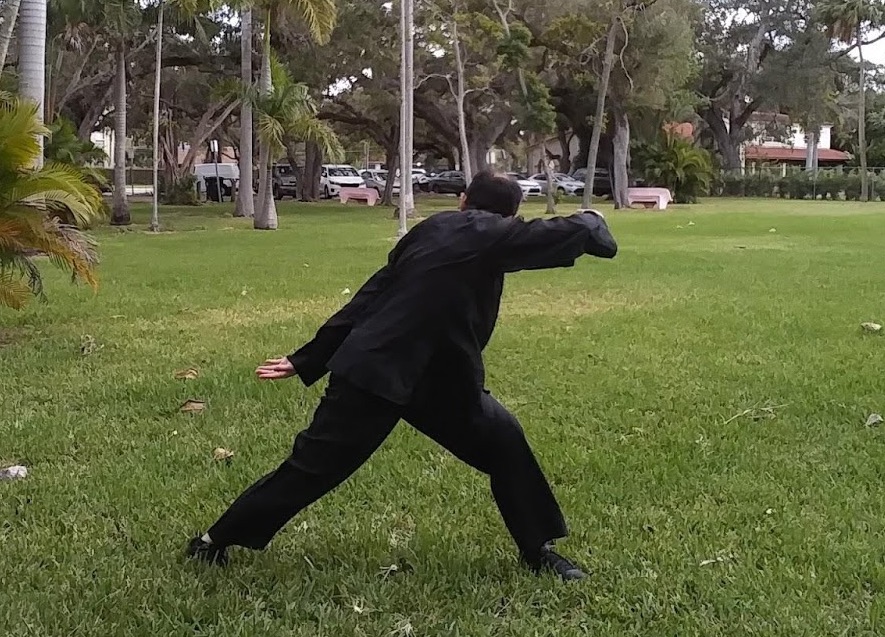
Dark Dragon Wags Tail
Dark Dragon Wags Tail is one of many curious appearing patterns in Baguazhang. What possible benefit is there to leaning forward deeply in the Bow Arrow stance while having one forearm parallel to the ground and the other arm stretched backwards? One reason deals with training the intense flexibility and freedom of joints needed to be able to deliver a strike from any direction. When practiced for stance training, this pattern is very effective at developing flexibility in the waist and shoulders, locations which are very commonly tight, especially in modern practitioners who are more accustomed to sitting in chairs and at computers than anything else.
This posture also reinforces the appropriate alignment and withdrawing of the scapula towards the spine, strengthening the muscles of the back as well as releasing tension from the chest muscles, for otherwise the scapula would not be able to move correctly into place. I have also found that force is focused at the bent forearm as well as outstretched rear palm.
In combat, especially when engaged with multiple opponents and using the tactic of "Fierce Tiger Enters a Herd of Sheep" (briefly, plunging into a crowd of enemies and using your agility to fight your way through them, as opposed to the tactic of "Rear Wall Battle" where you assume a safe position and force your opponents to come to you), if you are occupied with an opponent in front of you and someone approaches from behind, you may apply sinking or retaining force with your front forearm while simultaneously shooting your rear palm behind you at abdomen or groin level to buy yourself a second or two of breathing space before making an escape.
When delivering such awkwardly positioned attacks, however, it is important to be mindful of how you will escape an even more awkward position, such as if the opponent at your rear catches your rearward wrist or moves to the side to deliver an attack to your lower back or bottom while simultaneously controlling the opponent at your front or sides in a decisive enough manner to allow you to deliver the rearward attack in the first place. This and many other, stranger, and more outlandish situations have occurred in sparring, and hence while no one can prepare a specific counter for every specific situation, you can train the force, agility, speed, accuracy, and all other underlying qualities to give you the best chances to survive even the most unexpected attack.
Whirlwind Sweeps Leaves has a rather obvious application, capturing an opponent's upper body or kicking leg and then pulling or sweeping them over the straightened leg of your Bow Arrow stance in a similar fashion to Fisherman Casts Net from Taijiquan's famous Grasping Sparrow's Tail sequence.
In a pinch, the strong momentum generated from waist rotation and a solid stance also trains the force needed to deliver horizontal chops and sweeps with the arms and palms, translating easily into a palm strike that claps up at the ear, a hooking punch to the temple, a sharp horizontal elbow to the ribs, or even a close quarters blow from the shoulder.
Patterns such as this exemplify why it is important to spend an appropriate amount of time on fundamental practices of any art (such as the Mother Palms of Baguazhang, One Finger Shooting Zen of Southern Shaolin kung fu, Eighteen Lohan Art of Northern Shaolin, Cloud Hands of Taijiquan, and the Five Fists of Xingyiquan). The benefits they provide go far beyond the surface level.
Knight Plays With Lion is a rather well known pattern that even those with a cursory knowledge of Baguazhang can recognize. It has many hallmarks of the more flamboyant Baguazhang patterns, similar to Cloud Dragon Returns Head in the eighth Mother Palm or Great Roc Spreads Wings from the Eight Internal Palms, such as both arms thrusting out in either direction and the practitioner seeming to take up much more space than their body would otherwise occupy.
This pattern quite naturally shoots force to the fingertips while simultaneously opening and relaxing the joints of the spine, shoulders, elbows, wrists, and fingers, more easily allowing the transmission of force from the practitioner's stance to the extremities, laying the foundation for the future development of inch force, that is, the ability to deliver an exceedingly powerful blow without having to pull back and wind up for the strike.
The combination of a raised leg as well as a hand pattern is often seen in a genre of kicking techniques called No Shadow Kicks, where a distracting hand pattern (which may be a feint or a real attack) is used to distract an opponent from the real kick below. Some patterns include Rising Dragon Galloping Tiger (a simultaneous back fist and snap kick to the lower body) and Shoot Spear at Yun Pavilion (a simultaneous vertical punch and thrust kick), both of which are patterns found in Northern and Southern Shaolin kung fu.
Likewise, the withdraw from a Bow Arrow to the Single Leg stance enables the practice of escaping an opponent's attempt to throw you using techniques such as Whirlwind Sweeps Leaves, or any other throwing technique that relies on putting leverage across the legs. By removing the opponent's point of leverage, you nullify the greater portion of their throwing strength. Thrusting your fingertips at their eyes, nose, or throat further distracts them from being able to effectively marshal their remaining strength to throw you to the ground.
Granted, in actual application, you may or may not thrust your palms in opposite directions, but in solo training, doing such is very effective for the reasons listed above. If you do decide to escape an opponent's throw by lifting your leg into the Single Leg stance, be aware that you are likely still not as stable or as rooted in your Single Leg stance as an opponent who had assumed a stance with a solid enough structure in a bid to attempt to throw you. Be prepared to quickly step in another direction or to take advantage of your already raised leg to kick your opponent if the circumstance calls for it.
34. Turn Body Palm
Turn Body Palm emphasizes quick direction change in a one hundred and eighty degree arc and develops the use of Unicorn Steps to immediately strike an opponent that has snuck up behind you using Strange Python Turns Body. While much of Baguazhang is performed from the Stream Character stance, narrowing the stance to the Unicorn Stance with a shift forwards or backwards provides a few inches of space to avoid an incoming strike.
However, given that many opponents in my experience do not perfectly place their strikes but rather plough through space with wild abandon, my own preference is to include a bit of sideways step when withdrawing into the Unicorn Stance to further dissipate an opponent's incoming force. Much like with Alone Chop Hua Mountain, the descending chopping palm of Strange Python Turns Body can be aimed at virtually any target on the opponent's upper body, especially their temple, cheekbones, or clavicle. In the Swimming Dragon set practiced in the Shaolin Wahnam, after dislodging a bear hug applied by an opponent from behind, Strange Python Turns Body is used to strike them.
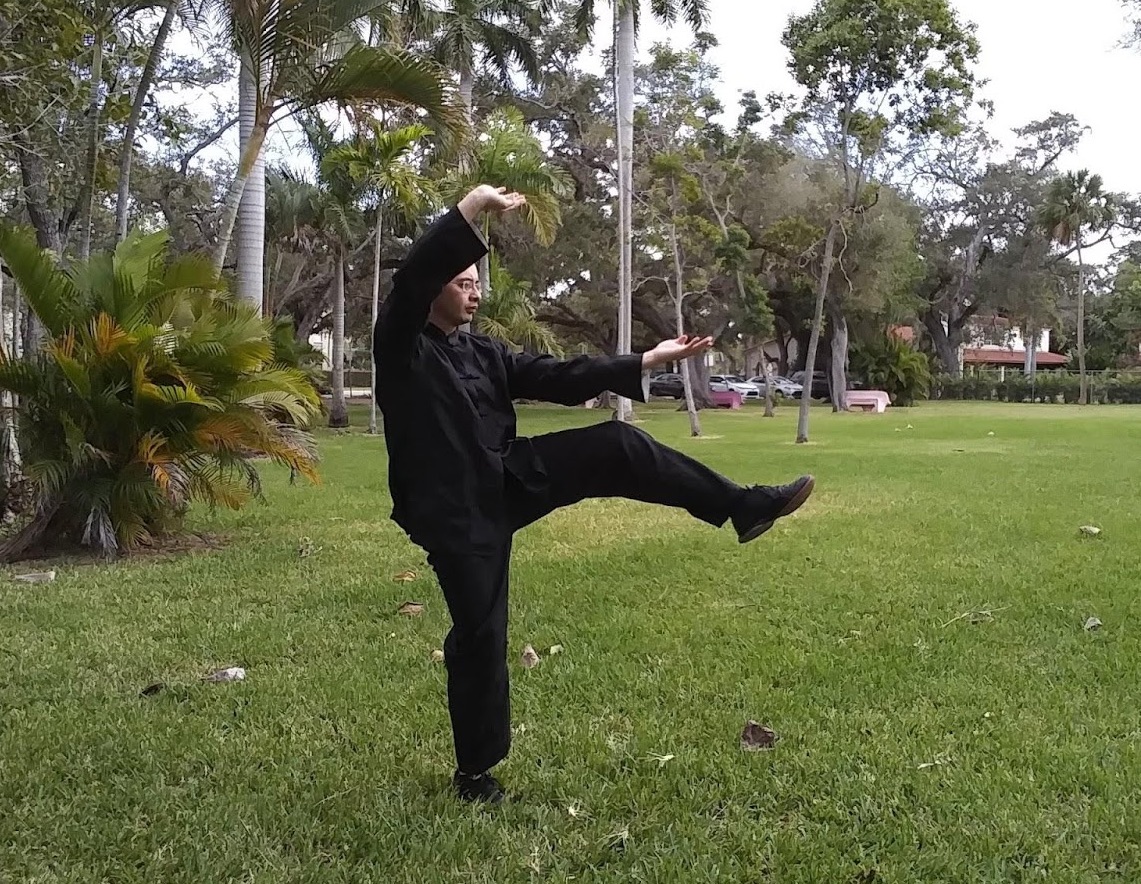
Cloud Dragon Rests on Pillow
Cloud Dragon Rests on Pillow serves as the fifth Mother Palm's next pattern as well as the stance chosen for Eight Mother Palms force training. Similar to Knight Plays With Lion, it is a pattern that maximizes the use of the practitioner's limbs, bringing many weapons and types of force to bear to a situation. Needless to say, this and other similar patterns require the utmost balance and strength to be effective in fighting. The amateur practitioner should use a simpler and less demanding pattern for any situation.
The most obvious application seen if every limb were used simultaneously includes floating away an incoming strike, thrusting the reverse palm at an opponent's eyes, either as a feint to distract them or as an actual strike, and simultaneously kicking them in the groin. When trained as a static posture for force, Cloud Dragon Rests on Pillow develops excellent balance, floating force, piercing force which is especially useful for strengthening and delivering strength through the fingers, balance even in awkward positions, and at a physical level, teaches the student to rely more on their core and spinal muscles to support their kicking leg rather than the muscles of the thigh, which in turn lets them move their hips directly from the hinge of their hip rather than trying to swing their thigh forward from their quadriceps.
Naturally, the question may arise as to whether or not a simultaneous hand strike and kick can be effective, given that a strike and a kick have a difference in their optimal range. A leg is far longer than an arm, for example, and, especially with a snap kick, also called an organ seeking kick in kung fu, is most optimal along the arc formed by the swinging instep of the foot. A kick that is delivered with the express purpose of a simultaneous hand strike would have to compensate for the shorter range of the hand strike, either by changing the position of the kicking leg or to choke up on the striking point of the kicking leg, such as using the lower shin or even the knee, depending on the opponent's height. Is such a thing meaningful?
The answer to that question should be obvious to anyone who has engaged in actual sparring or fighting and has been accidentally (or maliciously) kicked in the groin. Suffice it to say, a powerful blow to the groin is often quite painful, regardless of whether or not it is delivered by the toes, instep, ankle, shin, or knee. Even practitioners of protective force such as Iron Vest, Golden Bell, and Cotton Art prefer not to get struck in the groin.
Direct experience aside, there is also the matter of training philosophy in kung fu, which harkens back to force training, one of the most important considerations of kung fu practice (the other being combat application). The force training of Baguazhang and all other forms of internal kung fu, including appropriately trained Shaolin kung fu and other so-called external forms of kung fu, fills the entire body with force, even if the exercises may tend to emphasize force at certain body parts, such as Golden Bridge at the arms and the abdominal dan tian, Baguazhang at the legs and palms, or Carrying Sun and Moon at the chest.
The force training involved at both the basic level of training as well as in specialized training makes the entire body powerful, including less optimal body parts for a certain technique, be it the toes, instep, shin, or otherwise. Philosophy aside, remember that in the end, what matters is that you have escaped from combat intact while your opponent has been dealt with in a decisive fashion. The level of mercy that you allow to flow from your hand (or foot) is at your discretion.
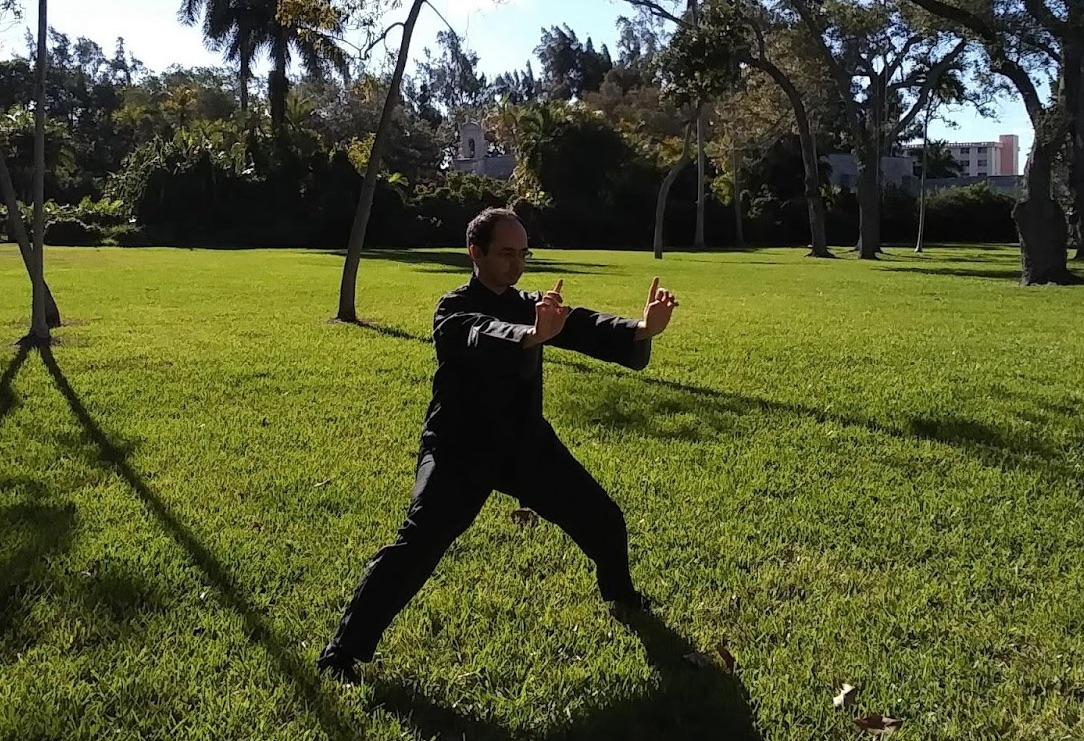
Golden Bridge
Hundred Birds Return to Nest is another excellent pattern that showcases the advantage of Baguazhang in using quick, closing steps to lend additional force to a strike. A common situation to use this pattern involves an opponent at close quarters using both arms to deliver or support an attack to the upper body or head, such as a two handed grab to the neck or shoulders, a double handed attack such as the Double Butterfly Palms, or even just using one hand to press down your guard and one hand to punch.
The outward flaring arms of Hundred Birds Return to Nest provide a wall or bridge that prevent your opponent's arms from closing inwards as you slip forwards into their space with a T step to deliver a double inward palm strike to their chest. Naturally, this pattern is not locked into a double palm strike, and one hand can certainly be used to tame or cover the opponent while using the other hand to strike. Even other famous double handed attacks such as Double Butterfly Palms from the Southern Shaolin Flower Set, Double Dragons Play With Pearl from the Shaolin Five Animals Set, or Embrace Moon in Bosom from Northern Shaolin Tantui often use one hand or forearm to disable the opponent's guard or to otherwise maneuver them into an uncomfortable position while the other hand delivers the actual strike. Occasionally, the hands are not even what delivers the actual attack, such as Lion Opens Mouth in Wudang Taijiquan, where both arms can be used to forcefully float an opponent's guard entirely and to throw them back into the range of a kick from below.
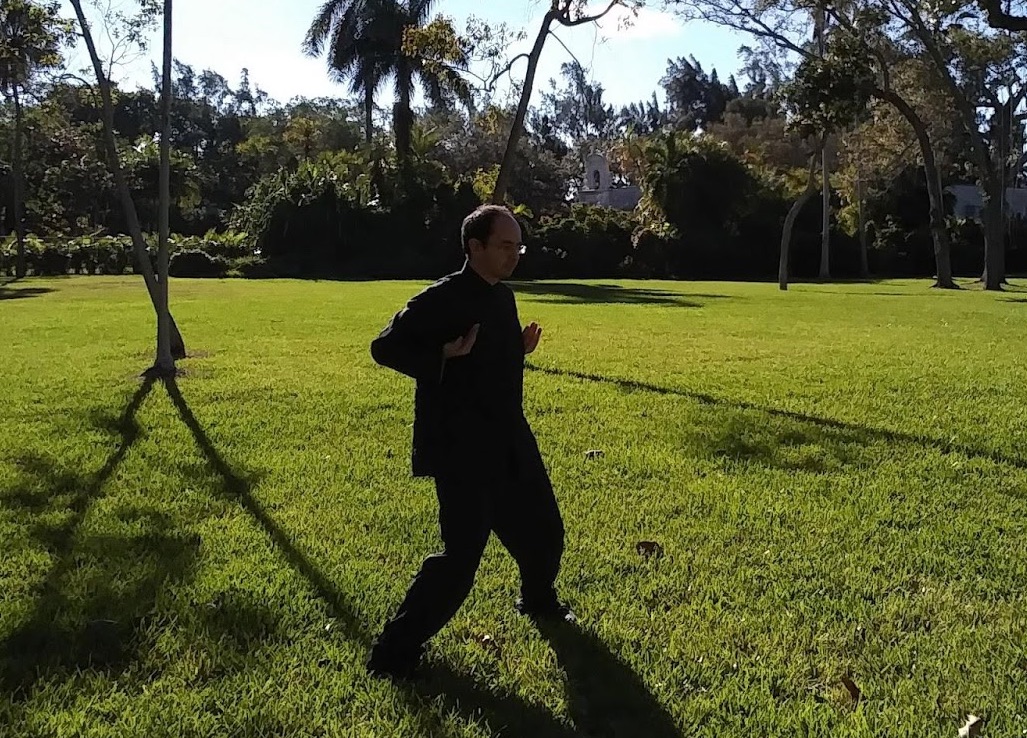
Carrying Sun and Moon
Returning to Hundred Birds, when delivered with enough force to the chest, can cause the muscles of the chest wall to be temporarily stunned, leading to a crisis in breathing for the opponent and a hard stop in most people's ability to continue combat. One of my masters told me, "When I want to stop someone from fighting, I take away three things from them: their sight, their breathing, and their stance. Most people can't fight with even one of those missing, much less all three" [13].
I personally do not know how long such a "stun" lasts, as the two times this attack was inflicted upon me, it was very quickly reversed by the master who applied it on me during sparring, but those were among the most terrifying five seconds of my life. Needless to say, be careful when training this pattern with your classmates. When a practitioner has sufficient force built at their abdomen as well as their palms, it is exceedingly easy to drive power into the opponent's body due to the positioning of the striking hands as well the forward momentum provided by the sudden half step forward.
The use of the half step forward to deliver additional impetus to a strike is seen especially in Xingyiquan and Chen Taijiquan, and to a lesser degree, Shaolin kung fu and Wuzuquan, though in those styles a hard stamp is often applied to help vibrate the force inside of the practitioner before sending it into the opponent's body. While in Baguazhang, the stamp is not typically used (Hundred Birds Return to Nest uses a far gentler step forward into the T step), it is worth noting for practitioners of those styles to ensure that they are not using excessive force in stamping the ground, as I have met a surprisingly high number of practitioners who have given themselves knee and ankle problems from years of incorrect practice in that regard. Safety first in all things, especially if you are pursuing martial arts as a hobby and not as a means to defend yourself and your loved ones from death.
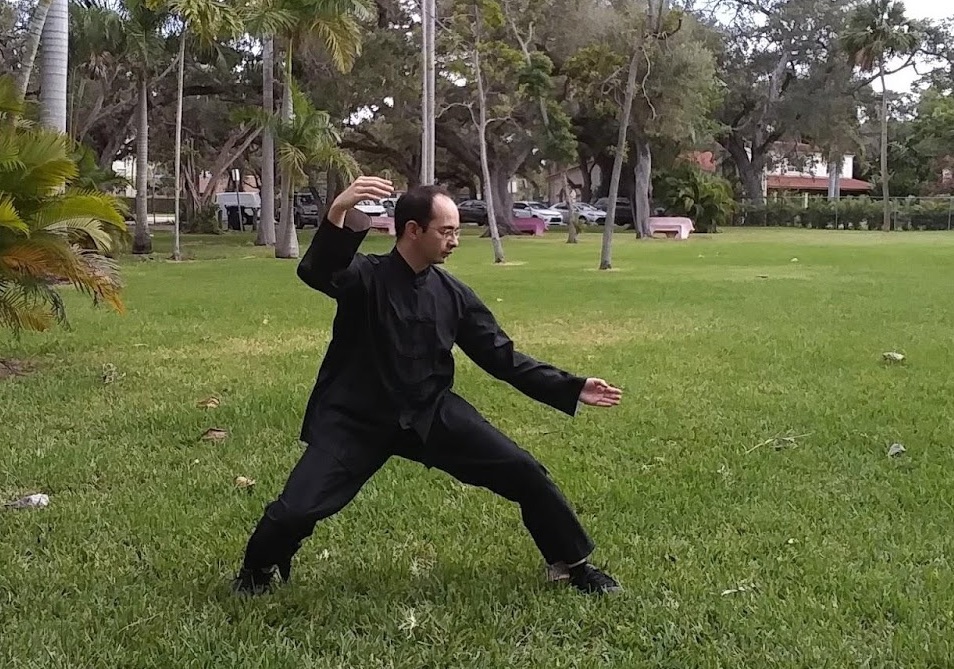
Peacock Spreads Tail
Peacock Spreads Tail rounds out the the fifth Mother Palm and, similar to Point to Heaven and Jab Earth, provides a pattern that, by dint of its step and body movements, allows a retreat from virtually any attack. In any martial art, be it those that have a handful of techniques (such as the Five Fists of Xingyiquan or the Eighteen Collection of Praying Mantis) or many dozens or even hundreds of techniques (such as Baguazhang's 64 Palms or the 108 Patterns of Yang family Taijiquan), it is important to have a few failsafe maneuvers that work for all occasions.
In Baguazhang, Point to Heaven and Jab Earth as well as Peacock Spreads Tail serve as those patterns. Grandmaster Wong further noted [17] every kung fu style has at least one, if not more patterns that can be used against any kick, such as Single Whip Saves Emperor in Northern Shaolin, Striking Tiger Poise in Taijiquan, or Lohan Strikes Drum in Southern Shaolin. Point to Heaven and Jab Earth as well as Peacock Spreads Tail are nemesis techniques against kicks in Baguazhang particularly because not only does the Baguazhang practitioner avoid the opponent's kick by nature of their stepping and body movements, the Baguazhang practitioner is immediately primed and ready to deliver their own counter-attack before an unwary opponent can begin to withdraw their leg.
In addition to its combat application, Peacock Spreads Tail can serve as an alternative to Cloud Dragon Rests on Pillow as a stance for Eight Mother Palms force training. It provides an example of what kung fu literature calls yin-yang harmony. While the legs, body, and torso are made solid and develop hard, consolidated force due to the nature of the Horse Riding stance, the arms and open palms, by comparison, have softer, flowing energy running along them and to the hands, enabling the practitioner to be both solid as well as fast.
35. Circle Body Palm
The sixth and seventh Mother Palms begin to use footwork and arm movements that are well known to the general populace, namely spinning about in spirals as well as whirling the palms about the body. The first pattern in Circle Body Palm is Big Boss Removes Helmet, where the practitioner may spin in a tight spiral while sweeping their arms and palms in a circle around their head and upper body before moving on to the next pattern.
The "helmet" being removed in this pattern is a neck or head lock, and generally one that is being applied from your front or side, and typically one that involves the opponent having one hand on top of your head and the other grasping the bottom near your chin. While dislodging a headlock applied from behind, such as a Full Nelson from wrestling, can be done, it is often more effective to use another technique. The spiraling turn performed in conjunction with the arm movements is characteristic of Baguazhang and further enhances the flow of force from the practitioner's body to their arms.
Even in the midst of a strike, kick, grapple, or throw, the Baguazhang practitioner gives further force and momentum to their techniques with the addition of taking a step, which is brought up again and again in the Songs and Methods of Baguazhang [22]. In my own experience with other martial artists, especially with my shorter height, reach, and slighter weight, it has always been my stances and footwork that provided victory, especially over stronger and larger individuals.
A particularly memorable occasion came up in the winter of 2016 when I visited a school of Chen Taijiquan to learn their Pushing Hands system. While the majority of them lacked the skills necessary for free sparring, such as the ability to deliver a powerful punch with correct spacing and timing, the majority of them had spent a significant amount of time playing at Pushing Hands and hence were quite adept at sensing and redirecting incoming force while remaining at a static position.
Without fail, however, the moment I added my footwork to the equation and began circling to their weaker points, their skills fell apart, not only in sensing but also redirecting my force. Likewise, the level of force that I was able to emit was much more than they could handle when I added a half step or a full step while they remained at their static posture.
Returning to the Circle Body Palm, Big Boss Removes Helmet is followed by Horizontally Sweep Thousand Armies. This horizontal arm sweep serves many purposes. At its most basic level, it can be used as a percussive strike like any other arm or hand strike, and if the arms are loaded with force and momentum such as from Big Boss Removes Helmet, it can be quite a staggering blow.
The body mechanic used in Horizontally Sweep Thousand Armies is effectively the mirror image of Whirlwind Sweeps Leaves from the fourth Mother Palm and can likewise be used to throw an opponent by sweeping their upper body while using the front leg of your Bow Arrow or Horse Riding stance as a fulcrum to throw them to the ground. If you wish to be nasty, instead of throwing the opponent to the ground, where they may have the opportunity to roll away, redirect your sweeping arms so that your opponent's head or back land on your thigh or knee.
Any technique in kung fu can be applied with varying levels of injury inflicted to an opponent. While it is a sure sign of mastery to be able to deal with an opponent in a manner that leaves them stunned, unable to continue fighting, but unharmed, such a scenario of "letting mercy flow from your hands" is not a realistic end point for all situations. Sometimes the decisive way of ending a situation that has escalated to physical violence is to be absolutely sure that the opponent is physically and mentally unable of inflicting violence to anyone else.
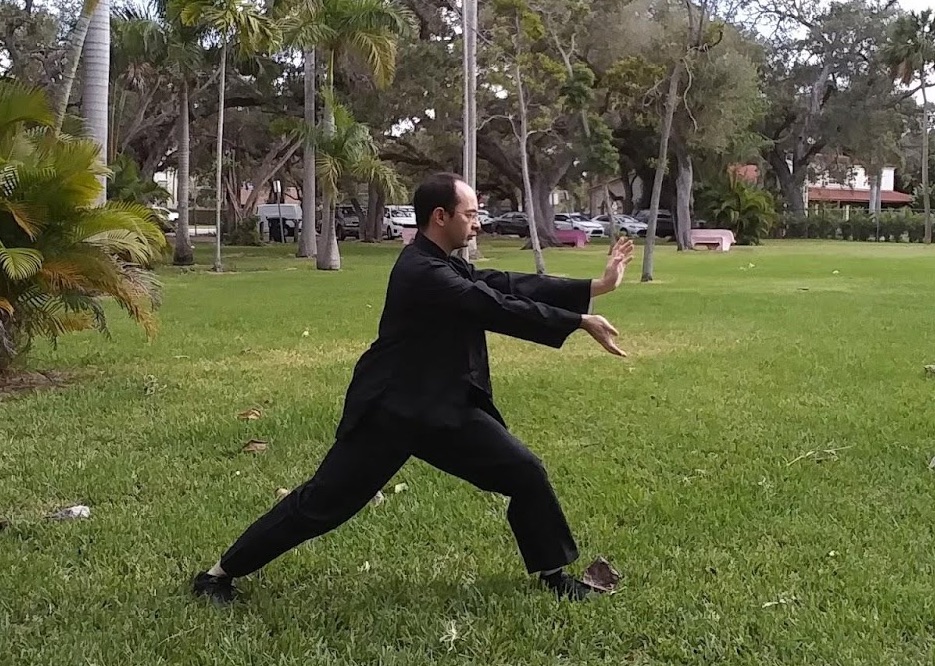
Lion Rolls Ball
Lion Rolls Ball is the last pattern of Circle Body Palm and it is important to remember that the pattern includes both the withdrawal of the body and palms after Horizontally Sweep Thousand Armies as well as the push forwards. In this fashion, Lion Rolls Ball incorporates the skills of the famous Double Butterfly Palms in application as well as the internal force of the Dragon for force. In a similar fashion to swallowing back in Grasping Sparrow's Tail from Taijiquan after warding off an opponent's force, the withdrawal of the body and palms can be used to swallow and dissipate an opponent's incoming force, for example shifting back away from an incoming thrust kick and using the palms to catch their foot before shifting forwards to push them away (twisting their ankle or knee is at your discretion) or capturing the head of someone attempting to charge your lower body (again, twisting their neck is at your discretion).
The shift as well as pressing of the two palms forwards allows many options for the type of force you wish to project at your opponent, though the most common ones used in this situation are striking force to deliver a blow that penetrates deeply into your opponent's body or release force to send them hurtling away. To those martial artists who are trained in the internal force of the Dragon, Lion Rolls Ball is an excellent pattern to train and manifest that force, and it is the hallmark of an expert Baguazhang fighter to manifest Dragon force with precise control.
Dragon force is a skill discussed in both Northern and Southern Shaolin kung fu and especially so in schools that emphasize internal force. The true hallmark of an expert in Dragon kung fu is being incredibly powerful while moving at the speed of thought. It requires tremendous internal force, meridians and body mechanics that are free from blockages, and a mind that is simultaneously clear, focused, and relaxed.
At its highest level, its force is a function of mind. The practitioner's mind (shen in kung fu parlance) and thoughts are used to guide energy to flow, which in turn makes the body move in the desired fashion, rather than moving through the simple biomechanics of muscular tension and muscle memory alone.
Grandmaster Wong is himself a specialist in the Southern Shaolin Dragon Energy Circulating set and his skill permeates the Baguazhang that he teaches [17]. Other sets and styles that emphasize Dragon force and the importance of the mind include the Northern Shaolin Dragon Form, which I was lucky enough to learn from Grandmaster Wong in 2018, and Bai Mei's Southern Shaolin Dragon kung fu. Low Tiger Kuntao likewise involves Dragon force training at its intermediate level as a specialization and its highest level includes a Dragon set, though unfortunately I was not privy to that advanced Dragon set [13].
The completing movement of Lion Rolls Ball, that is, sitting at the Bow Arrow stance after just having completed the double palm strike, is the static posture chosen to represent the Circle Body Palm. In addition to incorporating the benefits of training the Bow Arrow stance, tremendous force is built in the palms and wrists. In training this posture, it is important to keep the chest open, despite both palms pressing forwards, as the development of a chronically closed chest can lead to problems down the line for both health as well as fighting purposes.
36. Rotating Body Palm
The Rotating Body Palm consists of the most essential movements for Baguazhang combat application, with inward and outward spiraling steps that train the ability to move to an opponent's back with a single step. While typical Circle Walking will develop the stepping needed to flank an opponent with impunity, advancing that skill to get to their back is best achieved through the seventh Mother Palm, especially the spinning step called Green Dragon Coils Around Pillar.
Naturally, many who have watched me practice this Mother Palm at local parks have later come up to me and asked if I were practicing ballroom dance, waltz, or the Sufi mysticism of the Whirling Dervishes. The answer to all of those questions is an unfortunate no, and that the only dance that I have trained in my life was ballet for a few years in university. At any rate, the one time I tried tango lessons, when I went to spin my partner, my martial reflexes kicked in and I had to break off before I accidentally broke my partners arms as a result of this Mother Palm. Let this be a lesson to those martial artists who seek to engage with the rest of the world: always be in control of your art and do not become enslaved by your training.
Returning to the matter of the Rotating Body Palm, those martial artists trained in joint locks may notice the potential application of spinning to the flank or back of an opponent while capturing the opponent's wrist with one of your hands and floating upwards at that opponent's elbow with your other arm. The threat of pain, dislocation, and fracture is a great way to destabilize your opponent, besides the physical force of this joint lock forcing them upwards and causing them to be floating rather than rooted and enables you to more easily "take your opponent for a walk," as Grandmaster Wong notes [17], besides using them as a shield.
If you do decide to use this pattern to lead an opponent around, be aware that the arm you use against the underside of your opponent's elbow may be exposed and vulnerable to attack from the opponent's other arm or even to being bitten if the opponent is tall and flexible enough to reach, or to being attacked by another opponent, in which case you will have lost your leverage and gained an injury.
Another movement that some martial artists will be able to notice is that in the midst of spinning about, one of the arms coiling upwards and being lifted up to the sky. Naturally, this pattern is called Lift Hand Touch Sky and it is one of the most useful defensive patterns in the entire system. It serves as a similar pattern to the Thread Hand in Shaolin kung fu, using slanting movement and minimum force to dissipate the power of an incoming attack in a very economic movement.
Importantly, due to its training throughout this Mother Palm, the Baguazhang combatant learns to use it as a defense against any conceivable angle. In my own free sparring, this has saved me from being punched and kicked in the back of the head several times. In less stressful situations, the lifting arm of Lift Hand Touch Sky can be used to defend against virtually any strike aimed at the upper body or head and also serves as an excellent pattern with which to maintain contact with an opponent to sense their intention while stepping to their sides or back.
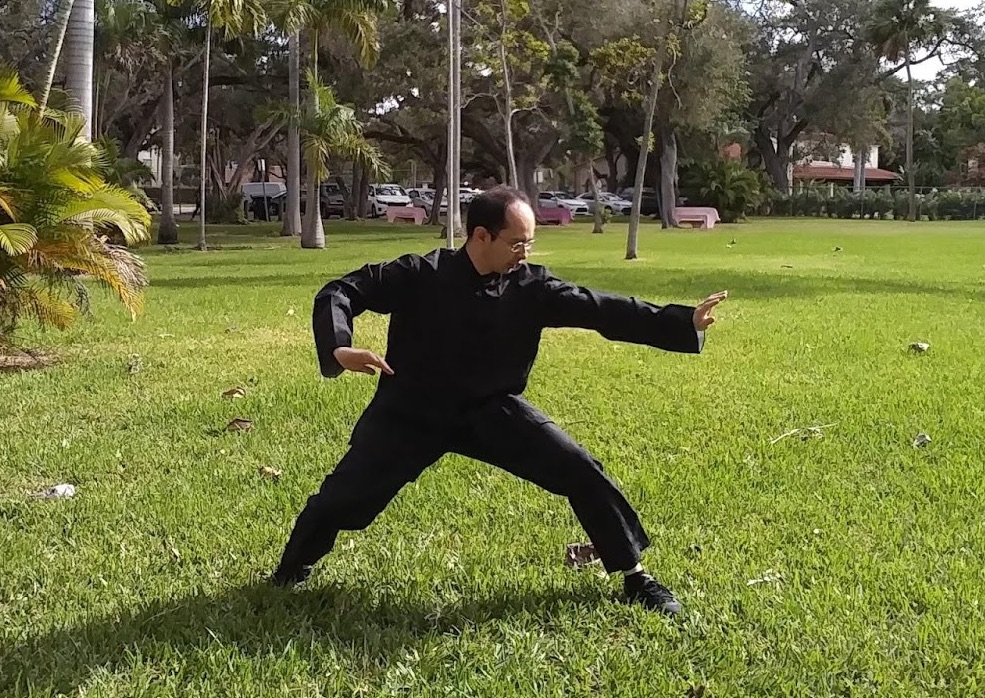
Horizontally Bar Rushing Horse
Horizontally Bar Rushing Horse serves as the final pattern for this Mother Palm as well as the recommended stance for Eight Mother Palms force training. Its application is discussed under Double Change Palm. When practiced for force training, it makes for an interesting contrast to Peacock Spreads Tail. While both use the Horse Riding stance as a base, the arm positions change the nature of the force without any need to apply the mind or breathing.
In a similar fashion to the use of the Hook Hand in Taijiquan's Single Whip to compress the force in the body like a spring to propel force out through the striking palm, Horizontally Bar Rushing Horse's bent arm (without the use of excessive muscular tension) encourages force to flow out to the front palm. This directed flow, rather than a diffuse spread of force, helps focus the practitioner's power exactly to where it must go, which tends to be directly into the opponent to hamper their fighting ability.
37. Return Body Palm
The Return Body Palm completes the Eight Mother Palms and begins with Lone Bird Flies Away where spreading and floating force are used to throw open an opponent's guard in preparation for a follow up attack. How damaging you wish to be when opening the opponent's guard is up to you. If you wish to be merciful, you may simply fling their arms open. If you wish to be nasty, you may scrape your fingertips across your opponent's face and eyes to further distract them before following with your coup de grace.
Regardless, as with all double handed patterns, not only can it be performed as a single handed variation, if you do decide to use it as a double handed maneuver, be aware of possible counters, especially more common ones such as an opponent shifting back in their stance and gripping your hands.
Thankfully, the immediate follow up pattern in Return Body Palm covers exactly what to do if an opponent grips your arm. Phoenix Snatches Nest is a formidable technique, delivering a double reverse palm thrust to the opponent's face and a simultaneous hidden kick from below. Baguazhang very rarely will use a kick or other leg technique in isolation; to enhance the success of leg techniques, it is often useful to perform a distracting hand or other upper body technique to draw the opponent's attention away from the kick. Even a leg technique can be used to distract for a follow up leg technique, such as the famous Yin Yang Kicks of Northern Shaolin or the Swaying Lotus Kicks of Taijiquan.
The coiling of the arms in Phoenix Snatches Nest serve to both transmit spiraling force from the body to the fingertips while also training the body mechanics needed to escape an opponent gripping your arms. Remember to be relaxed and not to fight the opponent's grip by pulling away. Coil and spiral your arms against the weaker part of their grip and, if need be, step forwards or to the sides in order to raise the chances of your escape. A Baguazhang combatant is always moving and using the strong points of their footwork and agility to maneuver into a more favorable situation, a feature that sees further application in the Swimming Dragon set.
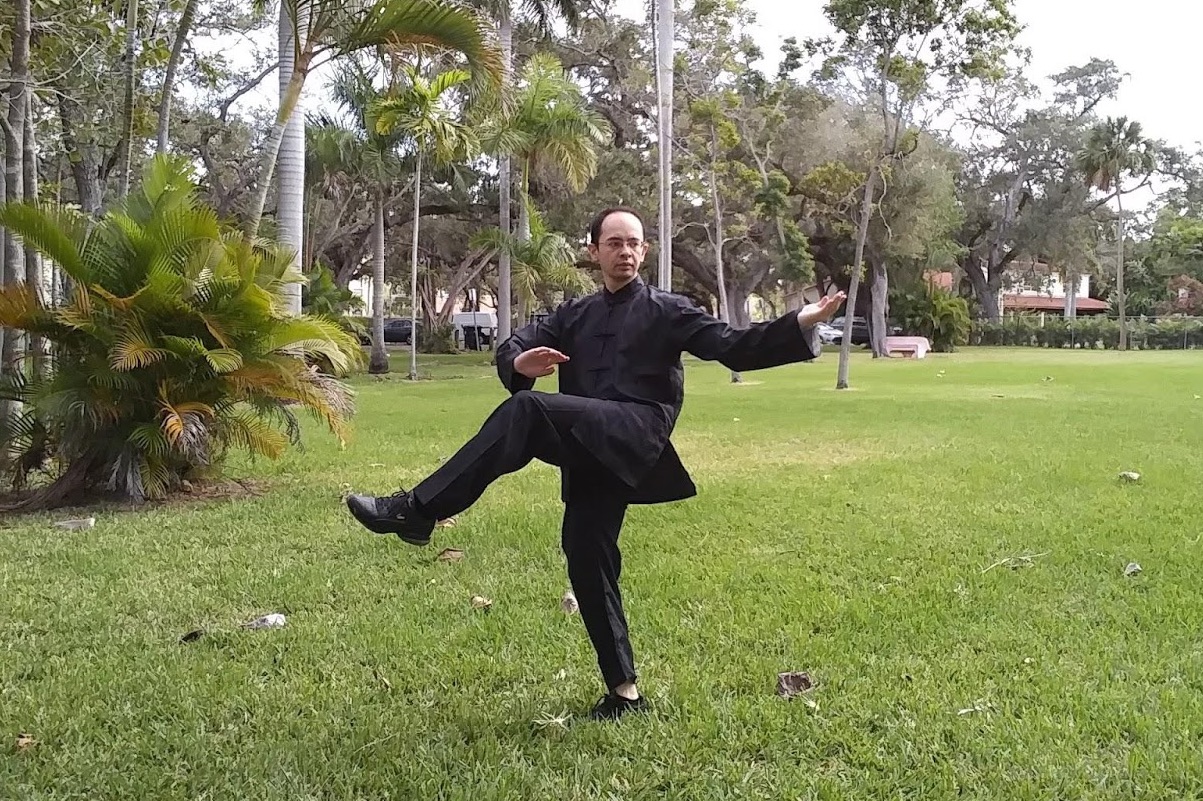
Cloud Dragon Returns Head
Cloud Dragon Returns Head is performed to either side after Phoenix Snatches Nest and is another lesson in delivering a forceful blow in multiple directions at the same time, including to awkward angles. The raised leg can simultaneously be used as a kick to one opponent as well as raising it to avoid an opponent attempting to directly attack it.
The reverse palm thrust off to one side can be used to strike at the face of a foe as well as the side of their neck or the area behind their ear to cause significant discomfort. If your timing and sensing skills are adequate, you may even use this technique against an opponent approaching from your flank or back and shoot out your palm, brushing aside their arm with your own arm and hitting them at the same time when they would have expected to hit you. Such a feat is a hallmark of an expert.
Cloud Dragon Returns Head is the recommended stance for Eight Mother Palms force training in this Mother Palm and trains significant flexibility in the spine, waist, and hips while also developing balance and, similar to Cloud Dragon Rests on Pillow, the ability to use the muscles of the spine and core, rather than only the quadriceps, to lift and move the legs, which further enhances the flexibility and strength of the waist and hips.
Monkey Presents Peach provides another opportunity to practice the spiraling and coiling body mechanics for which Baguazhang is famous. The half step leading up to raising one leg into the Single Leg stance (which can be a platform for a knee strike, kick, or to deflect an incoming leg technique) and delivering a raising double palm strike to an opponent's chin or throat uses similar philosophy to Hundred Birds Return to Nest.
Monkey Presents Peach can be used as a counter for an opponent who has thrown your arms out to either side (perhaps using an opening movement such as Lone Bird Flies Away) and attempts to close the distance quickly, whereby you can follow the opponent's opening momentum to bring your arms back close to strike upwards with both your palms and knee.
Great Roc Spreads Wings is the final pattern of the final Mother Palm and, as the name implies, develops spreading force, especially along the arms, which enables you to separate an opponent's guard, for example, if they attempt to choke or attack you, especially with both arms or if they attempt to perform a wrestler's shoot or grapple against you. Note that spreading the opponent's guard is only the first level of defense; you must follow up with a decisive strike or the opponent may simply leak around your spread to attack your exposed body.
As mentioned above, the Eight Mother Palms comprise the core of Baguazhang force training and combat application. Each school of Baguazhang has its own variations, but regardless of school or lineage, all state the importance of using the Mother Palms to develop force as well as skill with fundamental combat applications in order to use Baguazhang as a martial art.
It is highly encouraged that beginning Baguazhang practitioners (who, again, should ideally have a foundation in another martial art before pursuing Baguazhang as a specialization) spend some time developing force as well as training the applications of the Eight Mother Palms, initially in single step application and then gradually in combination as well as applying them against opponents from various angles and from different directions, so that they can eventually build the skills needed to use them in free sparring, before moving on to more advanced applications as seen in the Swimming Dragon set. Specific drills and exercises for expanding the student's ability to use Eight Mother Palms applications from straightforward situations to more sophisticated situations should be discussed with one's teacher.
The detailed use of Baguazhang methods for spiritual cultivation is beyond the scope of this treatise, though suffice to say that by making the body strong and flexible, generating a smooth flow of energy, and developing both a calm, focused, and clear mind through the Eight Mother Palms, the Baguazhang practitioner will be well equipped to pursue whatever method of spiritual cultivation they desire.
LINKS
Courses and Classes
